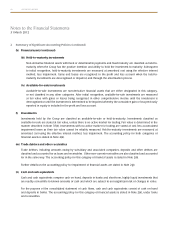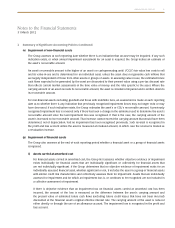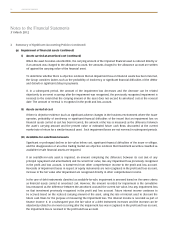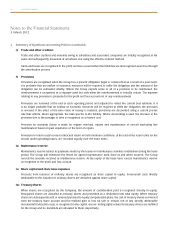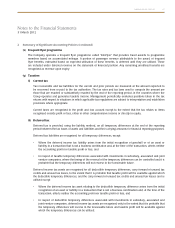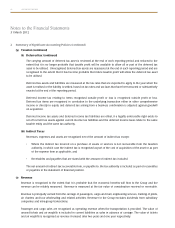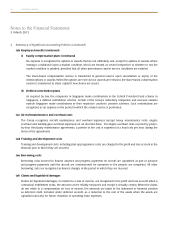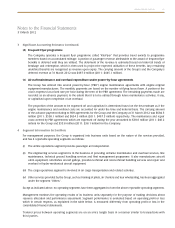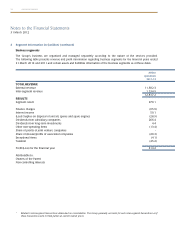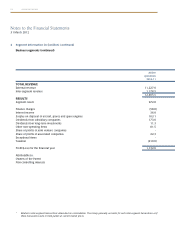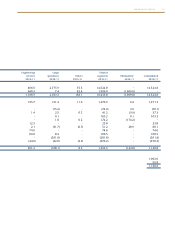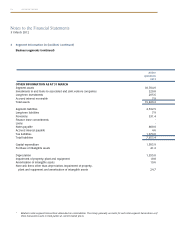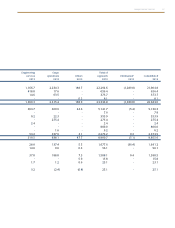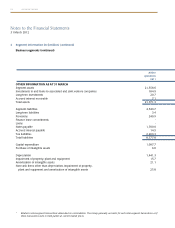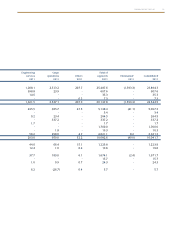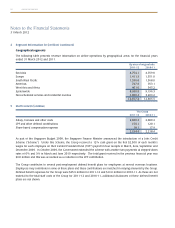Singapore Airlines 2012 Annual Report Download - page 122
Download and view the complete annual report
Please find page 122 of the 2012 Singapore Airlines annual report below. You can navigate through the pages in the report by either clicking on the pages listed below, or by using the keyword search tool below to find specific information within the annual report.
120 SINGAPORE AIRLINES
Notes to the Financial Statements
31 March 2012
2 Summary of Significant Accounting Policies (continued)
(ah) Segment reporting (continued)
(ii) Geographical segment
The analysis of revenue by area of original sale from airline operations is derived by allocating revenue to
the area in which the sale was made. Revenue from other operations, which consist principally of engineering
services and cargo operations, is derived in East Asia and therefore, is not shown.
Assets, which consist principally of flight and ground equipment, support the entire worldwide transportation
system, and are mainly located in Singapore. An analysis of assets and capital expenditure of the Group by
geographical distribution has therefore not been included.
3 Significant Accounting Estimates
Estimates and assumptions concerning the future are made in the preparation of the financial statements. They affect
the application of the Group’s accounting policies, reported amounts of assets, liabilities, income and expenses, and
disclosures made. They are assessed on an ongoing basis and are based on experience and relevant factors, including
expectations of future events that are believed to be reasonable under the circumstances.
The key assumptions concerning the future and other key sources of estimation uncertainty at the end of the reporting
period that have a significant risk of causing a material adjustment to the carrying amounts of assets and liabilities within
the next financial year are discussed below.
(a) Impairment of property, plant and equipment – aircraft fleet
Impairment is recognised when events and circumstances indicate that the aircraft may be impaired and the carrying
amounts of the aircraft exceed the recoverable amounts. Recoverable amount is defined as the higher of an aircraft’s
fair value less costs to sell and its value-in-use. The fair value less costs to sell computation is based on available
data from binding sales transactions in an arm’s length transaction of similar assets or observable market prices less
incremental costs for disposing the asset. In determining the recoverable amounts of the aircraft, certain estimates
regarding the current fair market value of the aircraft are made. The current fair market value is determined based
on desktop valuations from an independent appraisal for fleet with similar operational lives. When value-in-use
calculations are undertaken, the Group uses discounted cash flow projections based on financial budgets approved
by the management covering a specified period.
(b) Depreciation of property, plant and equipment – aircraft fleet
Aircraft are depreciated on a straight-line basis at rates which are calculated to write-down their cost to their estimated
residual values at the end of their operational lives. Certain estimates regarding the operational lives and residual values of
the fleet are made by the Group based on past experience and these are in line with the industry. The operational lives and
residual values are reviewed on an annual basis. The carrying amount of the Group’s and the Company’s aircraft fleet at 31
March 2012 was $11,024.2 million (2011: $11,111.9 million) and $8,985.5 million (2011: $9,137.5 million) respectively.
(c) Passenger revenue recognition
Passenger sales are recognised as operating revenue when the transportation is provided. The value of unused tickets
is included as sales in advance of carriage on the statement of financial position and recognised as revenue at the
end of two years. This is estimated based on historical trends and experiences of the Group whereby ticket uplift
occurs mainly within the first two years. The carrying amount of the Group’s and the Company’s sales in advance
of carriage at 31 March 2012 was $1,456.8 million (2011: $1,459.8 million) and $1,409.5 million (2011: $1,421.1
million) respectively.


